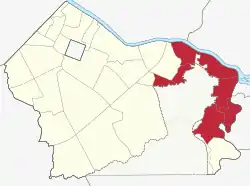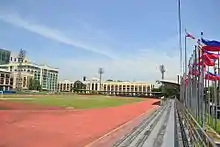Embo, Makati
Embo (sometimes capitalized as EMBO; from "Enlisted Men's Barrio") refers to a collective term for barangays administered by the city government of Makati. The barangays were originally established to house military personnel of the Armed Forces of the Philippines. The area is part of the larger disputed Fort Bonifacio area which is claimed by the city government of Taguig.
Embo | |
|---|---|
(2018-04-24).jpg.webp) West Rembo and Cembo | |
| Etymology: Enlisted Men's Barrio | |
 Map showing the Embo area within Makati | |
| Country | Philippines |
| Region | National Capital Region |
| City | Makati (de facto) Taguig (de jure) |
| First military settlement (Cembo) | 1949 |
| Transfer of control to Makati | 1986 |
| Area | |
| • Total | 3.05 km2 (1.18 sq mi) |
| Population (2015)[1] | |
| • Total | 178,817 |
| • Density | 59,000/km2 (150,000/sq mi) |
| Divisions | |
| • Barangays (as part of Makati) | 7
|
Etymology
The collective for the Embo barangays were derived from enlisted men's barrios (EMBOs).[2][3][4]
History
Part of the Embo area was formerly known as Mamancat. It was known as a trading hub alongside its more developed neighbor, Aguho in present day Pateros during the Spanish colonial era.[5]
At the end of the Philippine–American War, the United States colonial administration established the Fort William McKinley at the center of present-day Metro Manila. During World War II, the military reservation would be used as the headquarters of the United States Army Forces in the Far East (USAFFE) until the Imperial Japanese military took over it. After the conclusion of the war, the Philippines would be granted full independence by the United States in 1946 but retained control over its military bases.[3]
Fort McKinley would only be turned over to the Philippine government in 1949. The reservation was renamed as Fort Bonifacio and the government made plans to create settlements for military personnel within the vicinity of the installation.[3]
Cembo would be the first settlements among the EMBO barangays to be established. In 1949, when the first batch of enlisted servicemen from the Infantry Group, Philippine Ground Force from Floridablanca, Pampanga arrived to settle in the area.[6] In 1957, Comembo in the site formerly known as Mamancat would be settled by personnel from the Combat Engineering Group of the Philippine Army.[5]
In 1956, three more settlements would be authorized.[3] East Rembo[7] West Rembo[8] and Pitogo.[9]
Pembo would be established to for personnel of the First Ranger Regiment, who were also known as the Panthers.[10] In 1966, Cembo Annex was separated from Cembo proper and was renamed South Cembo.[11]
President Ferdinand Marcos issued Proclamation 2475 which transferred control of the Fort Bonifacio area to the city government of Makati in 1986 which also reserved the area for military personnel and their dependents. In 1990, President Corazon Aquino issued Proclamation 518 to award land titles in the EMBO area to bona fide occupants.[4]
In February 1996, a new barangay named Rizal was created from Pembo through Makati City Ordinance No. 96-010. Prior to the creation of Rizal, Pembo was larger than the neighboring municipality of Pateros with a land area of 123 hectares (300 acres) and a population of 65,000 in 1995.[10][12]
The Fort Bonifacio area including the Embo barangays would be subject of a territorial dispute between the city governments of Taguig and Makati. In 2022, the Supreme Court of the Philippines ruled that Makati should stop exercising jurisdiction over the Embo barangays although the Makati government has maintained that will continue to do so until it exhaust all legal remedies.[2]
Subdivisions
.svg.png.webp)
The Embo barangays are constituted as subdivisions of the city of Makati.[3][13] These barangays are part of Makati's 2nd congressional district.[14] Barangay Pitogo is also grouped with other barangays with "Embo" in its name.
| Barangay | Etymology | Population (2015)[1] | Area (km2) |
|---|---|---|---|
| Cembo | Central Enlisted Men's Barrio | 26,213 | 0.22 |
| South Cembo | 15,103 | 0.20 | |
| Comembo | Combat Enlisted Men's Barrio | 16,818 | 0.27 |
| East Rembo | Riverside Enlisted Men’s Barrio | 28,114 | 0.44 |
| West Rembo | 29,899 | 0.55 | |
| Pembo | Panthers Enlisted Men's Barrio | 48,275 | 1.23 |
| Pitogo | From pitogo, a local term for a palm plant.[15] | 14,395 | 0.14 |
| Total population and area | 178,817 | 3.05 | |
Education
West Rembo in particular is designated by the local government of Makati as the city's Center of Education and Cultural Affairs. It is the site of various public schools of the city such as the University of Makati and Fort Bonifacio High School.[8]
Religion

The Roman Catholic population is served by multiple parishes. The Mater Dolorosa Parish in East Rembo of the Amigonian Fathers and Brothers which was established on September 8, 1987 through a decree by Jaime Cardinal Sin. It originally covered the barangays of Cembo, West Rembo, East Rembo, Comembo, and Pembo. Cembo would later be transferred to the Our Lady of Guadalupe Parish.[16] The Saint John Of The Cross Parish would be established for Pembo on August 9, 1991.[17] On June 18, 1992, the Santa Teresita would be established in West Rembo. In 1998, a standalone parish for Comembo was proposed which was realized within the span of two years.[16]
References
- "Population of the National Capital Region (Based on the 2015 Census of Population)". Philippine Statistics Authority of the Republic of the Philippines.
- Garcia, Patrick (April 28, 2022). "Contested areas in SC ruling to remain under Makati City's jursidiction – LGU". Manila Bulletin. Retrieved April 30, 2022.
- Limos, Mario Alvaro (September 24, 2019). "The Military Roots of Cembo, Rembo, and Pembo Districts". Esquire Philippines. Retrieved April 30, 2022.
- Rufo, Aries (March 17, 2015). "How a Binay dummy got a P1B Makati property". Rappler. Retrieved April 30, 2022.
- "Comembo - History". Makati Web Portal. City Government of Makati. Retrieved April 30, 2022.
- "Cembo - History". Makati Web Portal. City Government of Makati. Retrieved April 30, 2022.
- "East Rembo - History". Makati Web Portal. City Government of Makati. Retrieved April 30, 2022.
- "West Rembo - History". Makati Web Portal. City Government of Makati. Retrieved April 30, 2022.
- "Pitogo - History". Makati Web Portal. City Government of Makati. Retrieved April 30, 2022.
- "Pembo - History". Makati Web Portal. City Government of Makati. Retrieved April 30, 2022.
- "South Cembo - History". Makati Web Portal. City Government of Makati. Retrieved April 30, 2022.
- "Rizal - History". Makati Web Portal. City Government of Makati. Retrieved April 30, 2022.
- Gamil, Jaymee (August 7, 2013). "Makati mayor sees 'takeover' of Bonifacio Global City in 2 weeks". Philippine Daily Inquirer. Retrieved April 30, 2022.
- Murcia, Alvin (February 14, 2022). "Bongbong barnstorms Makati". Daily Tribune. Retrieved April 30, 2022.
- "Pitogo - Introduction". Makati Web Portal. City Government of Makati. Retrieved April 30, 2022.
- "Historical Background". Mater Dolorosa Parish. March 13, 2015. Retrieved April 30, 2022.
- "Our History". St. John of the Cross Parish. Retrieved April 30, 2022.
